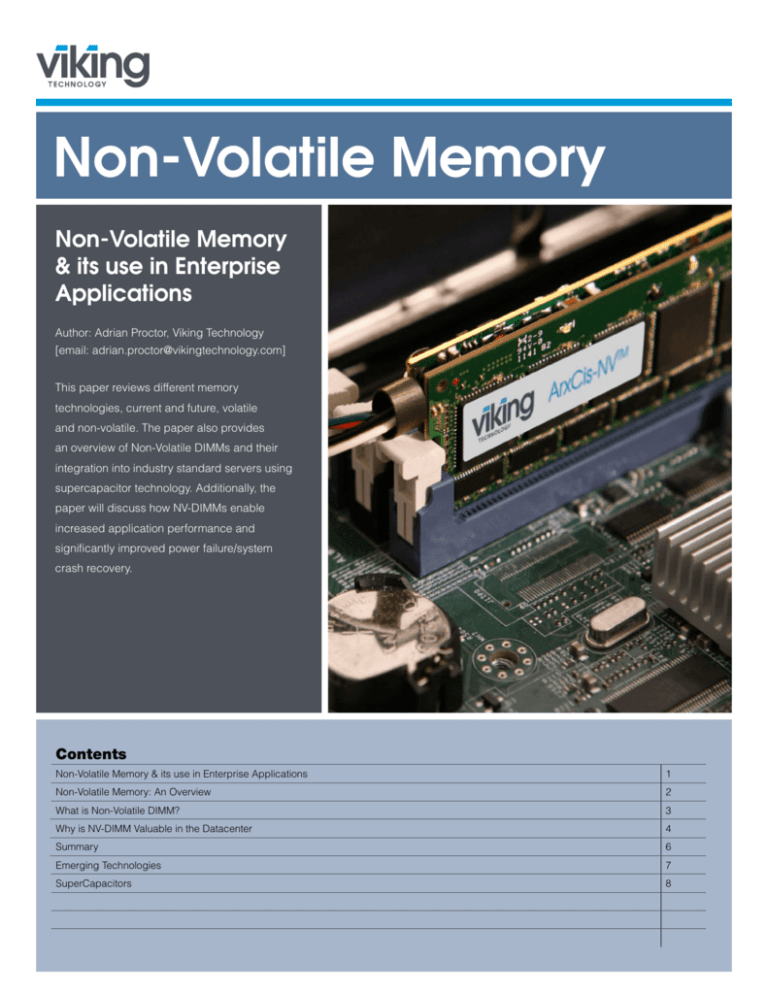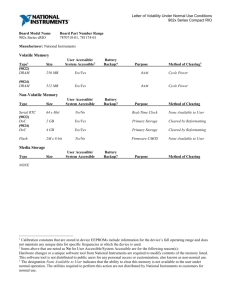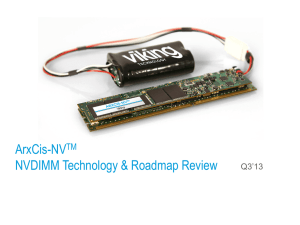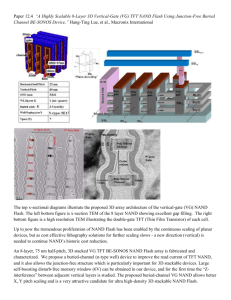
Non-Volatile Memory
Non-Volatile Memory
& its use in Enterprise
Applications
Author: Adrian Proctor, Viking Technology
[email: adrian.proctor@vikingtechnology.com]
This paper reviews different memory
technologies, current and future, volatile
and non-volatile. The paper also provides
an overview of Non-Volatile DIMMs and their
integration into industry standard servers using
supercapacitor technology. Additionally, the
paper will discuss how NV-DIMMs enable
increased application performance and
significantly improved power failure/system
crash recovery.
Contents
Non-Volatile Memory & its use in Enterprise Applications
1
Non-Volatile Memory: An Overview
2
What is Non-Volatile DIMM?
3
Why is NV-DIMM Valuable in the Datacenter
4
Summary
6
Emerging Technologies
7
SuperCapacitors
8
Understanding Non-Volatile Memory Technology
Whitepaper
Understanding Non-Volatile Memory Technology
Non-Volatile Memory: An Overview
Over the past 20+ years, numerous memory technologies have been brought to market with varying degrees of
commercial success, for example: Static RAM (SRAM), Pseudo Static RAM, NOR Flash, Eprom, EEprom, DRAM
and NAND flash. Generally speaking, these “memory” technologies can be split into two categories, volatile and
non-volatile; Volatile memory will not retain data when power is turned off, conversely non-volatile memory will
retain data once power is turned off. The two dominating memory technologies in the industry today are DRAM
(volatile) and NAND flash (non-volatile). See Figure 1 below which summarizes emerging, niche and those
memories in mass production:
Figure 1:
Categories of Memory
Non-Volatile
Memory
Volatile
Emerging
Technologies
ReRAM
STT-RAM
Niche
MRAM
FRAM
Mass Production
NAND
Emerging
Technologies
Floating
Body
Mass Production
DRAM
PCM
RaceTrack
NOR
EPROM
EEPROM
SRAM
Pseudo SRAM
MRAM
Emerging technologies: The memory technologies that dominate the computing industry today are, DRAM
and NAND flash; but it should be noted that both of these technologies have their pros and cons. DRAM delivers
the highest performance (latency / speed), with practically infinite endurance, yet it is volatile and has much lower
capacity points than other memories (i.e NAND flash). NAND Flash, on the other hand scales to high capacity
is non-volatile, relatively cheap ($/Gbit), but is significantly slower than DRAM, additionally endurance and data
retention are getting worse as process geometries continue to shrink, meaning that for write intensive enterprise
applications , NAND flash, in the long term, may well not be an optimal memory technology.
Gartner: Emerging Technology Analysis: The Future and Opportunities for Next-Generation Memory; October 2011
1
For more information, please visit www.vikingtechnology.com. Copyright © 2012 Viking Technology , all rights reserved.
2
Understanding Non-Volatile Memory Technology
Whitepaper
Understanding Non-Volatile Memory Technology
Figure 2:
Pro’s & Con’s of DRAM & NAND Flash
Technology
DRAM
Speed
•
Power
•
NAND
Capacity (GB)
Endurance
Pro’s & Cons of DRAM &
NAND Flash
•
•
Data Retention (Non-Volatile)
•
Cost/GB
•
Reliability
•
Technical Improvements with
Geometry Shrinks
•
There is much discussion in the industry as to what new universal memory technology or technologies will
materialize as real contenders to displace either or both NAND flash & DRAM. Some of these newer emerging
technologies2 include: MRAM (Magnetic RAM), FRAM (Ferroelectric RAM), PCM (Phase Change Memory), STTRAM (Spin-Transfer Torque RAM), ReRAM (Resistive RAM) and Memristor.
Currently FRAM, MRAM and PCM are in commercial production, but still, relative to DRAM & NAND flash, remain
limited to niche applications. There is a view that MRAM, STT-RAM and ReRAM are the most promising emerging
technologies, but they are still many years away from competing for industry adoption. Any new technology must
be able to deliver most, if not all of the following attributes in order to drive industry adoption on a mass scale:
scalability of the technology, speed of the device, power consumption to be better than existing memories, endurance, densities better than existing technologies and finally cost – if the emerging technology can only manage 1
or 2 of these attributes, then, at best, it is likely to be resigned to niche applications.
One important question is, “what will be the next non-volatile memory to replace NAND flash?” Currently
it is unclear, but due to the limitations of NAND flash (endurance, reliability, speed) when compared to DRAM,
it is likely a new non-volatile memory technology will evolve; but perhaps not replacing the current mainstream
memories for at least the next 5 to 7 years. However, non-volatile DIMMs, such as the ArxCis-NV™ from Viking
Technology can deliver an enterprise class solution to enable increased application performance and far improved power failure / system recovery, when compared to current implementations.
What is a Non-Volatile DIMM?
A Non-Volatile DIMM, is a module that can be integrated into the main memory of an industry standard compute
platform (i.e. server), perform workloads at DRAM speeds, yet be persistent & provide data retention in the event
of a power failure or system crash.
Emerging technologies summary
2
For more information, please visit www.vikingtechnology.com. Copyright © 2012 Viking Technology , all rights reserved.
3
Understanding Non-Volatile Memory Technology
Whitepaper
Understanding Non-Volatile Memory Technology
Viking Technology’s ArxCis-NV™, a non-volatile DIMM, is a memory subsystem that combines the speed and
endurance of DRAM, together with the non-volatile data retention properties of NAND flash. This marriage
of DRAM and NAND technology delivers a high speed and low latency “non-volatile / persistent” memory
module. Designed from the ground up to support unlimited read/write activity, it performs at fast DDR3
speeds and can sustain itself from host power failure or a system crash. This solution can be viewed as the
first commercially viable “Storage Class Memory” for the enterprise market.
What makes this module different from standard DRAM modules is that, in the event of a power failure or
system crash, the data in the NV-DIMM is securely preserved and available almost immediately upon power
being restored to the host system (suspend/resume).
Viking Technology’s ArxCis-NV™, has been architected to take advantage of the “best attributes” of the DRAM
& NAND memory technologies. Together with advanced data movement logic and supercapacitor technology,
the ArxCis-NV™ delivers exactly what the Enterprise market has been yearning for: A persistent, nonvolatile DIMM that can be integrated into the main memory of industry standard server hardware.
Why is an NV-DIMM valuable to the data center?
If performance is critical to business success and if minimizing down-time is an important issue, then NVDIMMs are valuable to your data center.
Some data center applications where Non-Volatile DIMMs would provide significant value are: searching/
mining, business analytics, digital media creation/transmission, financial modeling – essentially,
wherever the bottleneck is storage & I/O, and where downtime costs money.
Figure 3:
Performance gap between CPU
speed, SSD and HDD
For more information, please visit www.vikingtechnology.com. Copyright © 2012 Viking Technology , all rights reserved.
4
Understanding Non-Volatile Memory Technology
Whitepaper
Understanding Non-Volatile Memory Technology
With the recent surge in use of SSDs in the data center and those architectures also utilizing caching software
(auto-tiering), most applications have enjoyed significant performance improvements. Therefore the SSD
and software bundle has significantly improved the memory/storage gap, which has helped alleviate I/O
bottlenecks. However, the facts remain that NAND flash SSDs are best suited for read applications, not write
intensive ones. Therefore, these intelligent caching software solutions when paired with SSDs will utilize other
system resources to ensure performance & reliability (CPU, DRAM and HDDs).
Indeed most SSD caching software will utilize the host system’s standard DRAM for intensive write activity to
preserve the SSD and also keep the write cache in DRAM; which means, this critical data is susceptible to
loss in the event of a system crash or power failure. A common work-around to protect the data is to “checkpoint” the write buffer out into slower block based storage (i.e disk) at regular intervals, but “checkpointing”
naturally has a negative impact the I/O performance.
By integrating NV-DIMMs into the host system, data-centric and write intensive applications will enjoy a significant increase in performance. In addition to the benefits of increased application performance, recovery
is another area of significant benefit.
Should a data center experience a power outage, one of two scenario’s occur: either this power failure
causes a catastrophic loss of the “in-memory state”, or the backup power supplies enable the appliances
(servers) to transfer this data held in main memory out to disk; the entire state (which could be 100’s of
Gigabytes of DRAM) must be saved to a storage back end (i.e. NAS, SAN ). Both “saving” & “recovering/
reconstructing” this amount of data, across multiple servers will be extremely slow and place a very heavy
load on the storage infrastructure, resulting in severe I/O bottlenecks.
A real world example of this exact scenario: a large social networking site experienced a
power outage which caused the service to be down for 2.5 hours whilst in-memory cache
servers refreshed their state. This example can be seen as a successful data reconstruction
event, but 2.5 hours of downtime would cause negative financial impact to many businesses.
For more information, please visit www.vikingtechnology.com. Copyright © 2012 Viking Technology , all rights reserved.
5
Understanding Non-Volatile Memory Technology
Whitepaper
Understanding Non-Volatile Memory Technology
Summary
Power Failure/ System Crash: By utilizing Non-Volatile DIMMs, in the event a data center loses power
or experiences a system crash, the NV-DIMMs allow the servers to recover their “in-memory state” almost
instantaneously without putting any load on the storage back end (SAN/NAS) – in a sense, making the failure
appear as a suspend/resume event. This means that business critical applications such as OLTP (on-line
transaction processing) can be up and running again in a matter of minutes rather than hours & without the
need for UPS (uninterruptable power supply) intervention.
Data centers / Cloud service providers / Infrastructure as a service (IaaS) will have SLA’s (Service level
Agreements) in place with their customers to guarantee up-time; use of NV-DIMMs will help reduce any downtime caused by system crash or power failure event, thus providing significant financial value
Performance: The architecture of NV-DIMMs, provides a full interconnect on-module that will independently
allow transfer of data between the DRAM and the Flash without contention for other I/O or CPU resources.
Ultimately, applications can rely on the high speed memory (DRAM) to be “persistent” and not need slow
down to “checkpoint” or consume other system resources.
The NV-DIMM delivers value that far surpasses a simple DRAM DIMM and SSD architecture, it is greater than
the sum of the two technologies used.
For more information, please visit www.vikingtechnology.com. Copyright © 2012 Viking Technology , all rights reserved.
6
Understanding Non-Volatile Memory Technology
Whitepaper
Understanding Non-Volatile Memory Technology
Emerging Technologies
MRAM: Magnetic RAM.
MRAM is a non-volatile memory. Unlike DRAM, the data is not stored in a electric charge flows, but by magnetic storage elements. The storage elements are formed by two ferromagnetic plates, each of which can hold
a magnetic field, separated by a thin insulating layer. One of the two plates is a permanent magnet set to a
particular polarity; the other’s field can be changed to match that of an external field to store memory.
Vendors: Everspin (Freescale spin-off), Crocus Technology
STT-RAM: Spin-Transfer Torque RAM.
STT-RAM is an MRAM (non-volatile), but with better scalability over traditional Magnetic RAM. STT is an effect
in which the orientation of a magnetic layer in a magnetic tunnel junction or spin valve can be modified using
a spin-polarized current. Spin-transfer torque technology has the potential to make possible MRAM devices
combining low current requirements and reduced cost; however, the amount of current needed to reorient the
magnetization is at present too high for most commercial applications.
Vendors: Samsung, SK-Hynix, Renesas, Toshiba, Everspin, Crocus Technology.
PCM: Phase Change Memory.
PCM is a non-volatile random access memory. It utilizes the unique behavior of chalcogenide(a material
that has been used to manufacture CDs), whereby the heat produced by the passage of an electric current
switches this material between two states. The different states have different electrical resistance which can
be used to store data. It is expected PCM will have better scalability than other emerging technologies.
Vendors: Micron, Samsung.
ReRAM: Resistive RAM.
ReRAM is a non-volatile memory that is similar to PCM. The technology concept is that a dialectric, which is
normally insulating, can be made to conduct through a filament or conduction path formed after application of
a sufficiently high voltage. Arguably, this is a memristor technology and should be considered as potentially a
strong candidate to challenge NAND flash.
Vendors: SK-Hynix, HP, NEC, Panasonic, Samsung.
For more information, please visit www.vikingtechnology.com. Copyright © 2012 Viking Technology , all rights reserved.
7
Understanding Non-Volatile Memory Technology
Whitepaper
Understanding Non-Volatile Memory Technology
Supercapacitors
In order for the ArxCis-NV™, non-volatile DIMM to perform its task, a small energy source is required to ensure
100% data security on system failure. Supercapacitors are an ideal technology for use in this environment,
primarily because they provide a superior solution when compared to batteries.
Supercapacitor technology is relatively new to the enterprise arena; any technology, when new and relatively
unknown will encounter questions about long term reliability and capabilities. Here follows a few reasons why
supercapacitors are suitable for use in this type of enterprise application:
1. High Efficiency: Supercapacitors are highly efficient components. Their efficiency (defined as the total
charge removed divided by the total charge added to replenish the charge removed) is greater than 99%, even
at very high currents; meaning that little charge is lost when charging and discharging the supercapacitor.
2. High Current Capability: Supercapacitors are designed with a very low equivalent series resistance
(ESR), allowing them to deliver and absorb very high current. The inherent characteristics of the supercapacitor allow it to be charged and discharged at the same rates, something no battery can tolerate. In batterybased systems, you can only charge as fast as the battery will accept the charge.
3. Wide Temperature Range: Since supercapacitors operate without relying on chemical reactions, they
can operate over a wide range of temperatures. On the high side, they can operate up to 65°C, and withstand
storage up to 85°C, without risk of thermal runaway. On the low side, they can deliver power as cold as -40°C.
4. Condition Monitoring (SOC & SOH): Determining battery state of charge (SOC) and state of health
(SOH) is a significant factor for robust battery systems, requiring sophisticated data acquisition, complex
algorithms, and long-term data integration. In comparison, it is very simple to determine the SOC and SOH
of supercapacitors.
5. Long Cycle Life: The energy storage mechanism of a supercapacitor is capable of hundreds of thousands of complete cycles with minimal change in performance. They can be cycled infrequently, where they
may only be discharged a few times a year, or they may be cycled very frequently.
6. Long Operational Life: The energy storage mechanism of a supercapacitor is a very stable process. It
is capable of many years of continuous duty with minimal change in performance. In most cases, supercapacitors are installed for the life of the system.
7. Ease of Maintenance: Supercapacitors cannot be over charged/discharged, and can be held at any
voltage at or below their rating. If kept within their wide operating ranges of voltage and temperature, there is
no recommended maintenance.
8







